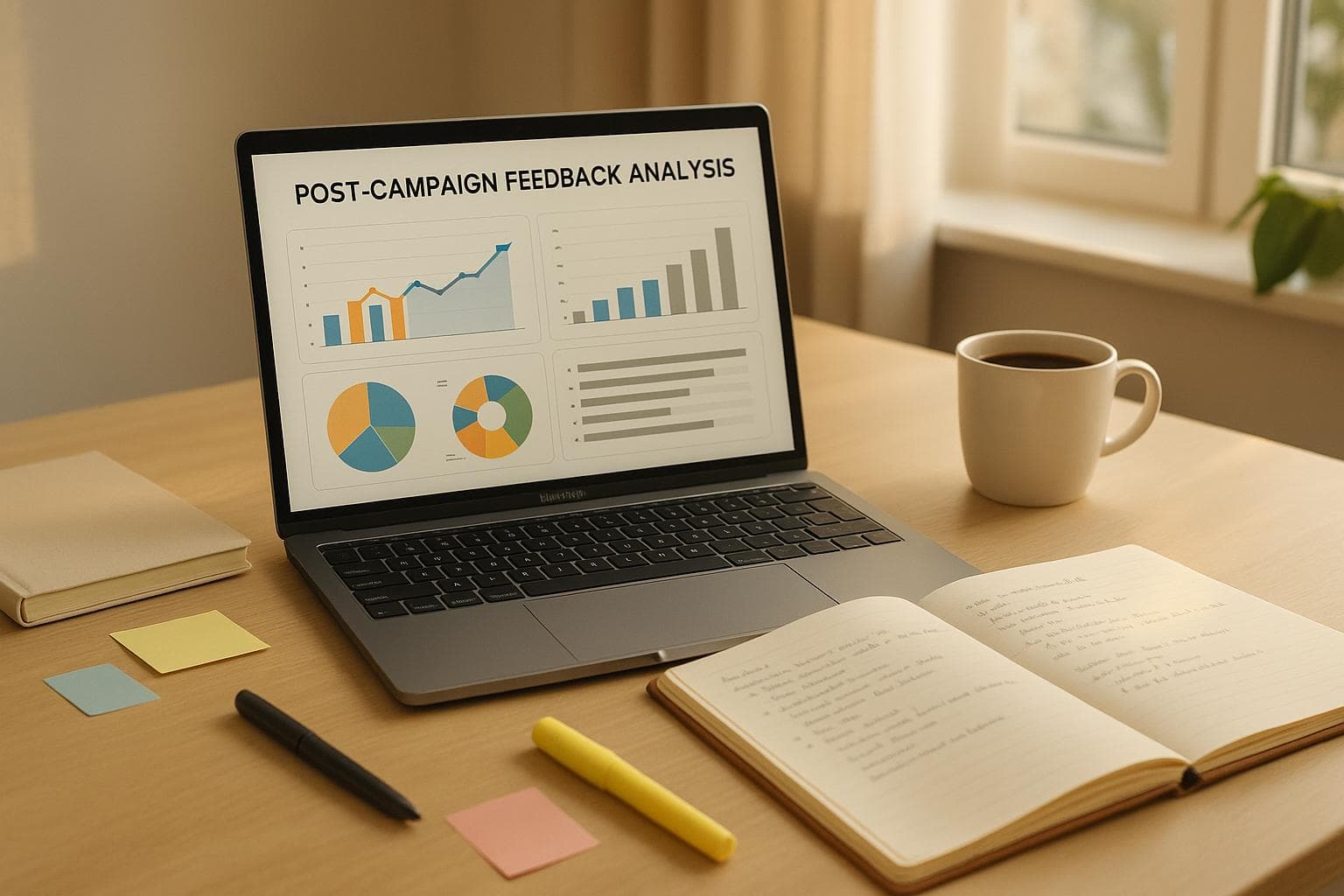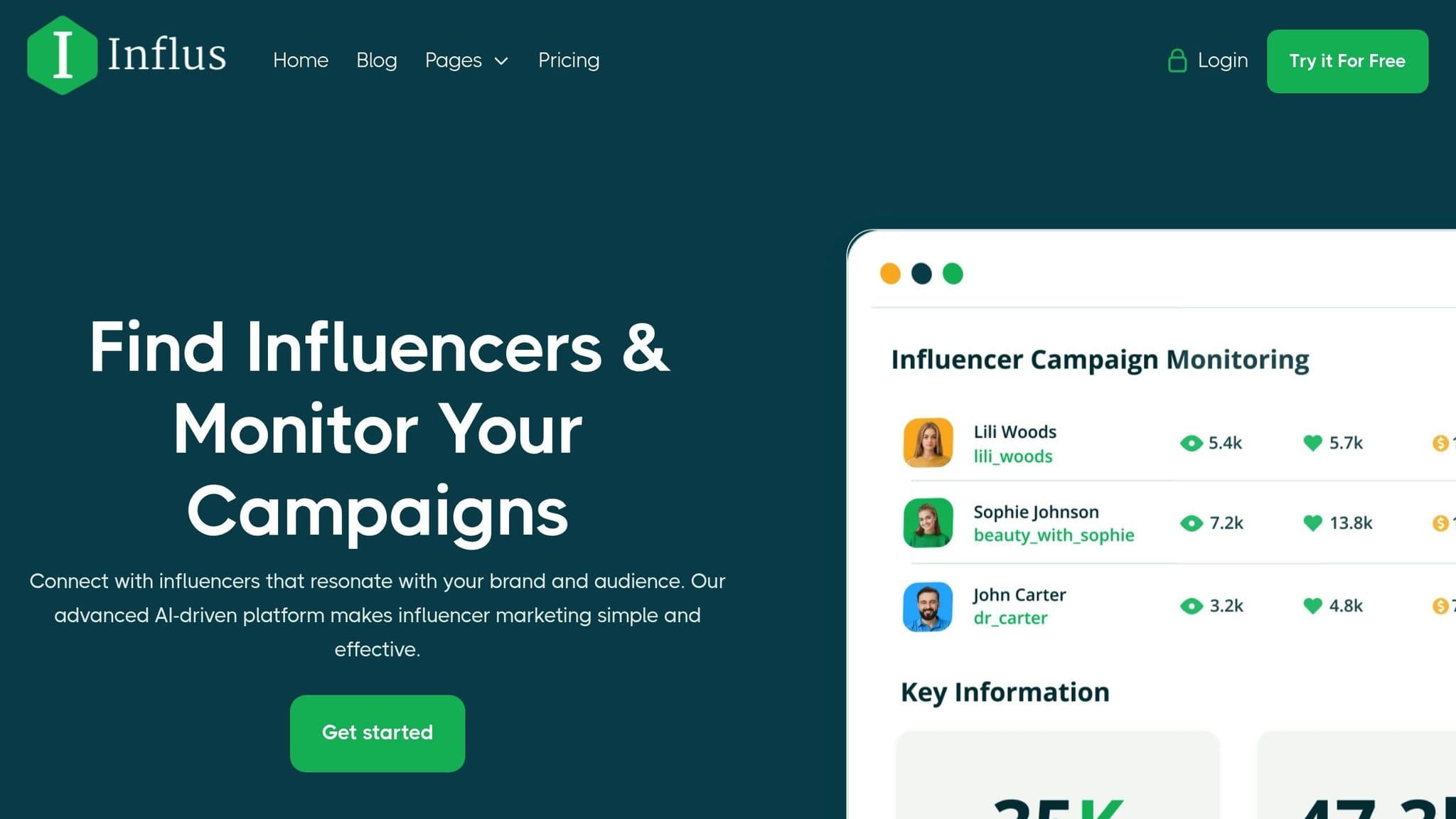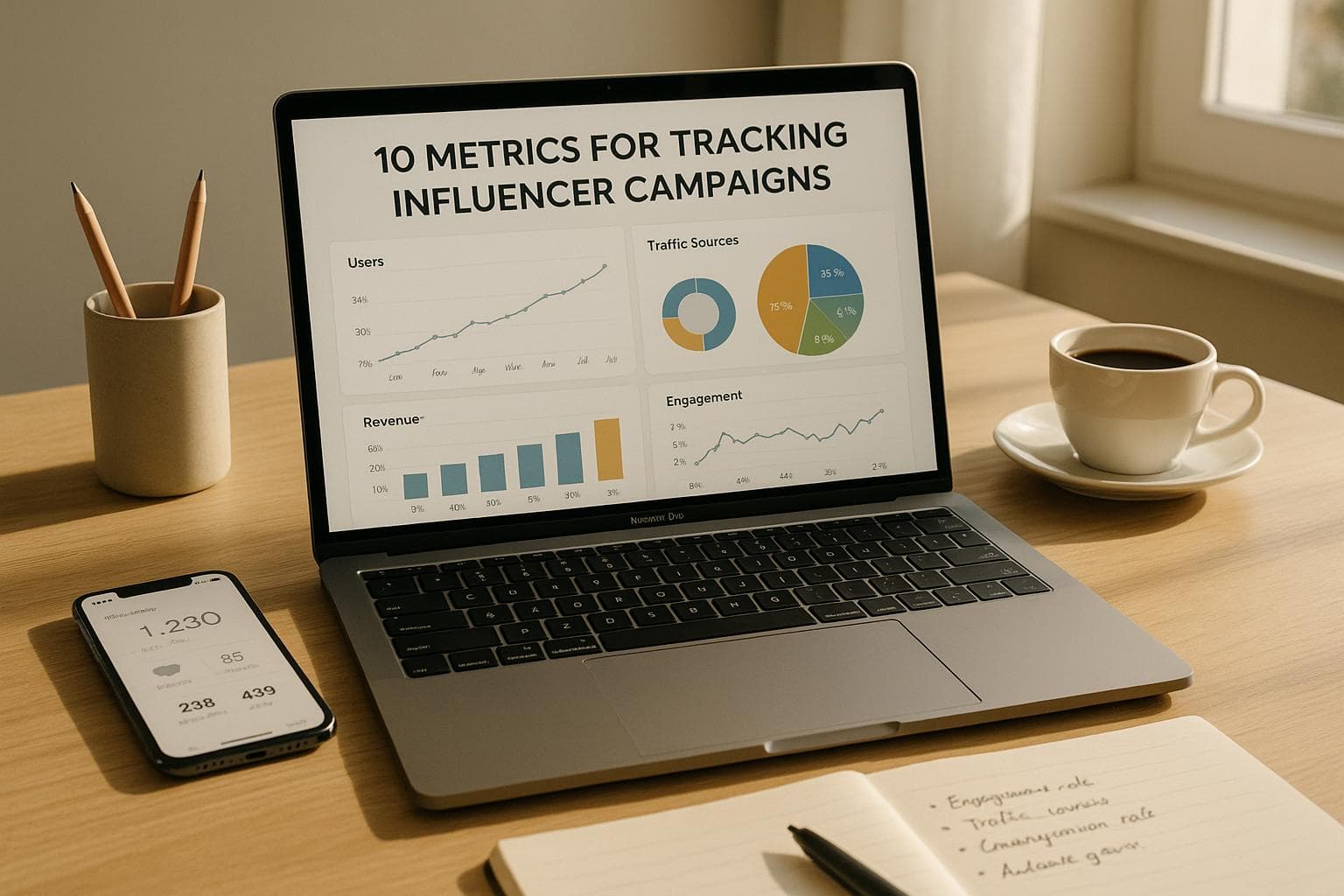Ultimate Guide to Post-Campaign Feedback Analysis
Unlock valuable insights from your marketing campaigns through comprehensive feedback analysis to enhance future strategies and optimize ROI.

Want to improve your marketing campaigns? Post-campaign feedback analysis is your answer. It helps you turn raw data into actionable insights, optimize your budget, and refine future strategies. Here’s what you’ll learn:
- Why it matters: Data-driven companies are 23× better at customer acquisition and 19× more profitable.
- What to analyze: Audience engagement, influencer performance, ROI, and customer feedback.
- How to do it: Use tools like analytics platforms, CRM systems, and social listening software.
- Key metrics: Track reach, sales, engagement, and brand mentions.
- Practical tips: Combine numbers with audience sentiment for a complete picture.
Bottom line: With the right approach, you can boost ROI, pick the best influencers, and create content that resonates. Let’s dive into the details.
Comprehensive Marketing Campaign Report Analysis with Power BI
Building Your Data Collection System
Creating a solid data collection system is the backbone of effective post-campaign analysis. It ensures you have the right tools and processes in place to evaluate performance accurately and gather meaningful feedback.
Data Collection Methods
To get a full picture of your campaign's performance, collect data from multiple sources:
- Social Media Analytics: Keep an eye on key metrics like post engagement, story interactions, comment sentiment, share/save rates, and audience demographics.
- Website Performance Data: Focus on metrics such as:
- Bounce rates (26–40% is considered excellent)
- Time spent on each page
- Conversion paths
- Mobile versus desktop performance
- Customer Feedback Channels: Collect qualitative insights through:
- Post-purchase surveys
- Social media comments
- Customer service interactions
- Direct messages from users
Required Tools and Software
The right tools can streamline data collection and management while ensuring compliance with privacy regulations. Here are some key categories and their uses:
| Tool Category | Purpose | Key Features |
|---|---|---|
| Analytics Platform | Campaign tracking | Real-time monitoring, custom reporting |
| Data Privacy Manager | Compliance | Consent management, data mapping |
| CRM System | Customer data | Contact management, interaction history |
| Social Listening | Brand mentions | Sentiment analysis, trend tracking |
Data Quality and Privacy Rules
Keeping data accurate and adhering to privacy regulations is non-negotiable. As Matthew Ramirez, a Serial Entrepreneur and Former Forbes 30 under 30 winner, puts it:
"Data privacy management software needs to have essential features encompassing data classification, data discovery, data masking, data loss prevention, and data encryption".
Here are some best practices to follow:
- Conduct regular audits and use automation to reduce errors.
- Cross-check data from various sources to ensure consistency.
- Communicate clearly with influencers to confirm details.
- Standardize data processes to maintain accuracy.
Aman Kumar emphasizes the importance of reliable data management:
"We ensure accuracy and reliability by utilizing advanced data management tools that centralize and organize influencer information. Regular audits, automated updates, and cross-referencing against reliable sources help maintain data integrity. We also implement manual checks to verify critical details and engage with influencers directly to confirm the most up-to-date information, ensuring consistent accuracy across campaigns."
To illustrate the benefits of proper data management, take the case of Spotify. In March 2023, Spotify, a Mailchimp client, reduced their email bounce rate from 12.3% to 2.1% in just 60 days by using Mailchimp's Email Verification API. This improvement boosted deliverability by 34%, resulting in $2.3 million in additional revenue (Mailchimp Case Studies, 2023).
Numbers and Feedback Analysis
Key Performance Metrics
Keeping track of the right metrics is essential for gauging how well a campaign performs. With brands expected to allocate a staggering $47.8 billion to influencer marketing by 2027, understanding these performance indicators is more important than ever.
Here are some key metrics to monitor, depending on your campaign objectives:
| Objective | Metrics |
|---|---|
| Brand Awareness | Reach, Impressions, Brand Mentions |
| Engagement | Likes, Comments, Shares |
| Conversion | Sales, Sign-ups |
| Community Growth | Follower Growth |
For instance, Flannels' TikTok campaign during Q3 2023 achieved impressive results: $4.42 million in sales, an 18× ROAS (Return on Ad Spend), and a reach of 11.9 million unique users in the UK. These kinds of numbers are great, but they only tell part of the story. To get the full picture, you also need to analyze how your audience is responding to the campaign.
Understanding Audience Response
Numbers are powerful, but they don’t tell you everything. Digging deeper into audience feedback can reveal how people perceive your campaign and its overall impact.
Here’s a simple framework for analyzing audience responses:
- Monitor Social Sentiment: Pay attention to conversations and emotional reactions surrounding your campaign. Are people excited, indifferent, or critical?
- Evaluate Engagement Quality: Look beyond likes and shares - focus on the depth and relevance of interactions. Are comments meaningful, or are they just emojis?
- Segment Audience Responses: Break down feedback by demographics or other audience segments to uncover patterns.
A great example comes from MAPFRE, an insurance company that leveraged personalized campaigns. Their tailored content achieved a 2.65% engagement rate, outperforming the 2.27% rate of their non-personalized posts. By mapping out audience sentiment, you can combine these insights with your performance metrics for a more comprehensive analysis.
Merging Stats with Feedback
When you combine performance metrics with audience feedback, you unlock actionable insights that can elevate your campaigns.
"Quantitative data provides the 'what' and 'how much,' while qualitative data illuminates the 'why' and 'how.'"
For example, a global retailer boosted sales by 15% in just one quarter by analyzing both purchase data and social media sentiment. Similarly, Chanty refined its marketing strategy based on customer feedback, resulting in an 18% increase in sales.
Here’s how you can integrate these insights:
- Track the User Journey: Combine metrics like sessions and conversions with qualitative inputs such as customer comments or survey responses.
- Find Connections: Look for patterns between numerical data and audience sentiment to identify what’s working - and what isn’t.
- Create Actionable Changes: Use these insights to fine-tune your campaigns, whether it’s adjusting your messaging, targeting, or influencer partnerships.
This kind of integrated analysis not only strengthens your decision-making but also ties back to earlier discussions on influencer selection and campaign optimization.
"It lets you establish whether your campaign will be a TOFU, MOFU, or BOFU play. TOFU makes the most sense for Later because our product is a long lead. However, a fashion brand might want to build BOFU campaigns to drive conversions."
sbb-itb-0e1095d
Using Results to Improve Campaigns
Digging into your post-campaign data can unlock smarter decisions for influencer selection, content creation, and budget allocation. Let’s break it down.
Improving Influencer Selection
Here’s a surprising insight: bigger isn’t always better when it comes to influencer follower counts. Influencers with 50,000–250,000 followers deliver about 30% better ROI than those with 250,000–1M followers, and 20% better than influencers with over 1M followers.
When choosing influencers, focus on these critical areas:
| Analysis Area | What to Measure | Why It Matters |
|---|---|---|
| Sentiment Performance | Audience reactions and comments | Shows the quality of engagement |
| Authenticity Check | Follower authenticity rate | Helps avoid fraud - 36.8% of Instagram influencers faced fraud in 2024 |
| Value Alignment | Brand voice consistency | Ensures the influencer represents your brand authentically |
| Engagement Quality | Comment depth and relevance | Indicates a genuine connection with their audience |
"Include sentiment performance in your post-campaign influencer evaluations - not just reach or clicks." - Cam Khaski Graglia, Content Strategist
By analyzing this data, you’ll refine your influencer strategy and ensure your messaging hits the mark with the right audience.
Better Content Planning
A strong content strategy, backed by data, is the backbone of successful campaigns. Did you know content marketing generates three times as many leads as traditional outbound methods - and costs 62% less?
To fine-tune your content approach:
- Keep a close eye on engagement trends.
- Segment your audience to deliver tailored messaging.
- Experiment with headlines and visuals.
- Align content with each stage of the buyer’s journey.
These steps help ensure your content connects with your audience and drives meaningful results.
Smart Budget Planning
Once you’ve nailed your influencer and content strategies, it’s time to put your budget to work. Start by evaluating your campaign’s ROI. Poor data optimization leads to 31% of marketing budgets being wasted. On the flip side, data-driven companies are 23 times more likely to acquire customers and 19 times more likely to see profits.
Using tools like Influs’s real-time analytics, especially when integrated with platforms like Shopify, allows you to track ROI with precision and fine-tune your spending.
"I always like to help the client understand goals before launching and help establish realistic expectations." - Sonya Koerner, CEO and co-founder of Interactive Max Marketing
Here’s how to make the most of your budget:
- Track Channel Performance: Identify which platforms and influencer types yield the best ROI.
- Monitor Customer Acquisition Costs: Compare your spend against the lifetime value of your customers.
- Adjust in Real-Time: Shift your budget to high-performing campaigns as you go.
- Experiment with Formats: Test different content styles and promotional strategies to see what resonates most.
Analysis System Setup
Building on solid data collection and feedback loops, a well-structured analysis system ensures campaigns keep improving over time.
Standard Analysis Steps
To streamline your analysis process, follow this framework:
| Analysis Phase | Key Activities | Outcome |
|---|---|---|
| Data Collection | Gather metrics from all channels | A complete performance dataset |
| Performance Review | Compare results against objectives | Gap analysis and actionable insights |
| Insight Generation | Extract learnings | Strategic recommendations |
| Documentation | Compile detailed reports | A knowledge base for future campaigns |
For even greater efficiency, consider using Influs Analytics to automate these steps.
Using Influs Analytics

Influs Analytics simplifies campaign evaluation with real-time tracking and detailed reporting. Its integration with platforms like Shopify provides precise ROI calculations and other performance metrics. Here’s what Influs Analytics can do:
- Engagement Tracking: Keep tabs on likes, comments, and shares across campaigns.
- Audience Analysis: Dive into demographic data and behavioral trends.
- Fraud Detection: Spot and filter out fake engagement to ensure data accuracy.
- Performance Benchmarking: Compare your results to industry standards for a clearer perspective.
One standout example is Colgate-Palmolive. By adopting systematic analytics tools for their influencer campaigns, they managed to cut campaign costs by 40%.
Measuring Long-term Results
While immediate feedback is valuable, tracking long-term metrics ensures your strategy remains effective. For example, an educational app study revealed that 50% of sign-ups happened in the first two months, but the remaining conversions trickled in over the next year. By Month 12, customer acquisition costs had dropped by 58%.
Key metrics to monitor include:
| Metric Type | What to Track | Measurement Period |
|---|---|---|
| Brand Growth | Share of voice, brand mentions | 6–12 months post-campaign |
| Customer Retention | Repeat purchase rate | 3+ months after the first purchase |
| Content Performance | Engagement with evergreen content | Ongoing |
| ROI Evolution | Trends in cost per acquisition | Monthly for 12 months |
"The most innovative leaders recognize influencer marketing is not merely a trend, but a transformative strategy that can propel your brand positioning and product strategy while bridging authenticity with reach." - Tim Clarke, Vice President of Product Marketing at Sprout
Conclusion
Analyzing the results of your influencer campaigns isn't just a final step - it's a game-changer. On average, brands see a return of $5.78 for every $1 spent on influencer marketing, making it clear why a structured approach to post-campaign analysis is so valuable.
Keeping an eye on real-time performance and staying flexible with adjustments is crucial. Why? Because emotions often play a bigger role than logic in how audiences respond. This is where sentiment analysis becomes a powerful tool, helping marketers understand how people really feel about their campaigns.
By leveraging data, marketers can take meaningful actions like these:
| Action | Impact | Timeframe |
|---|---|---|
| Fine-tune Messaging | Boosts engagement | Immediate to short-term |
| Choose Better Influencers | Aligns with target audience | Mid-term |
| Adjust Content Strategy | Increases ROI | Long-term |
These steps translate directly into better campaign results. For example, in the beauty industry, analyzing audience feedback revealed a lack of product education. By shifting toward more educational content and refining their messaging, brands saw a noticeable increase in engagement and positive sentiment.
The best-performing brands view feedback analysis as an ongoing effort. With 67% of companies reporting higher ROI from influencer marketing compared to other channels, understanding audience sentiment isn’t just a nice-to-have - it’s a must. Regularly reviewing feedback not only sharpens your strategy but also helps you stay ahead in a competitive market.
FAQs
How can I collect accurate data for post-campaign analysis while staying compliant with privacy laws?
To ensure accurate data collection for post-campaign analysis while staying compliant with privacy laws, start by being clear and upfront with users. Let them know exactly what data you’re gathering, why it’s necessary, and how it will be used. This kind of openness helps build trust and keeps you aligned with regulations like the California Consumer Privacy Act (CCPA).
Always get explicit consent from users before collecting any data. Not only does this comply with privacy laws, but it also lowers the chances of running into legal trouble. Focus on collecting only the data that’s absolutely necessary for your analysis - this minimizes risks tied to data breaches and compliance issues.
On top of that, prioritize robust data security measures and make it a habit to regularly review your processes. Privacy regulations are always evolving, and staying current ensures you protect both your data and your audience’s trust.
How can I combine qualitative audience feedback with quantitative data to improve future marketing campaigns?
Combining feedback from your audience with hard data offers a clearer picture of how your campaign is performing and highlights areas that need work. Start by diving into qualitative feedback - things like customer comments or survey responses - to understand the why behind the numbers in your metrics. For example, if you notice a dip in engagement, customer feedback might point to issues like confusing messaging or unmet expectations.
To make the most of these insights, look for recurring themes in the feedback - common sentiments or concerns - and compare them against performance metrics like click-through rates or ROI. This comparison helps you identify specific changes to improve future campaigns. Additionally, methods like interviews or focus groups can uncover subtle details that raw data might overlook, ensuring your approach is both informed by data and aligned with customer needs.
How do I choose the right influencers to boost ROI and connect authentically with my audience?
To select the right influencers for your campaign, start by clearly defining your campaign goals and getting a solid understanding of your target audience. This ensures the influencers you choose align with your brand’s values and genuinely connect with the people you want to reach. Focus on finding creators whose content, tone, and engagement style naturally fit your brand identity.
When evaluating potential influencers, dig into their engagement rates, check their audience demographics, and assess how well their content aligns with your niche. Influencers who build authentic connections with their followers and maintain openness about partnerships tend to drive stronger engagement and better returns on investment.
If you’re looking for a faster, more streamlined approach, tools like Influs can be a game-changer. These AI-powered platforms help you discover and connect with influencers that match your goals while providing real-time analytics to track performance and fine-tune your campaign.
Related posts
- Guide to Instagram Analytics for Influencer Selection
- 8 Common Influencer Marketing Mistakes to Avoid
- Top 7 Influencer Dashboard Metrics to Track
- ROI Tracking for Micro-Influencer Collaborations
Related Posts
Continue reading with these related articles


